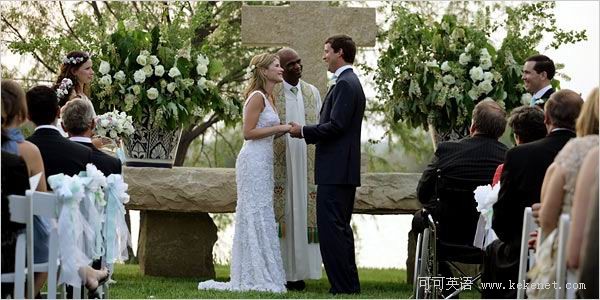(单词翻译:单击)
听力练习
Wedding customs and traditions
The idea of having bridesmaids1),pages2),a best man and ushers originated with the belief that evil spirits,envious of the couple’s happiness,would be out to harm them,but would be confused by so many similarly dressed people.The custom of the best man probably goes back to the days when the groom took a friend with him when he went to kidnap the bride from her home.Bells were originally rung at weddings to frighten away the evil spirits,and noisy celebrations were held beforehand to try and drive them from the community.These were the ancestors of our stag and hen parties.

The Ancient Egyptians were probably the first to use wedding rings:in hieroglyphics3),the circle was the symbol of eternity.The ring can also symbolize the bonds of a captive.
The Hindu ceremony takes place under a canopy of brocade or some other richly decorated material,festooned with flowers.The bride,wearing a red silk sari,is the first to arrive,but she hides out of sight until the bridegroom,robed in white,has been brought in by his friends and relations.As he enters,lights are waved over his head and grains of rice are thrown,a ceremonial act symbolizing riches and fertility.
In the Buddhist ceremony the bride and groom sip three times from each of three bowls of increasing size to symbolize how their lives will grow together.
In past times it was customary to shower the bride and groom with petals as they left the church,and for them to walk along a path strewn with flowers.This charming idea gave way in the era of mass production to paper confetti.In some countries,rice is thrown,to symbolize fertility and plenty.Beware,it could hurt if thrown with great vigour.
White wedding dresses have been in the forefront of bridal fashion since Queen Victoria broke with the royal tradition of a silver dress and opted4) for white for her wedding to Prince Albert in 1840.
The going-away car is often decorated by high-spirited friends with messages in lipstick and shaving foam,and tied about with balloons,tin cans,and old boots.The“old boot”tradition is an ancient one and stems from the time when the father,on giving away his daughter to the groom,presented him also with one of her slippers.This gave the new husband,symbolically speaking,the up per hand,for he was supposed to thrash5) her with it should she displease him.The slipper was put at the bed head on his side of the bed to remind his wife w ho was boss.However,if she became the dominant partner,neighbours transferred the power of the slipper to her,and christened6) her“the old boot.”
In the Jewish wedding ceremony the couple are married under a chuppah7),a canopy of s ilk or velvet8) held up by four posts.This is a relic o f the time when the children of Israel lived in tents.It symbolizes the bridal chamber.To some it signifies the home the couple will make together;its fragility reminds the couple of their own weakness and the need to nurture their union in order to ensure its survival.During the ceremony the bride and groom drink wine from the same glass,symbolizing that they will share all things.The bridegroom then dashes the glass to the floor and grinds it under his foot.Some say that this is a reminder of the destruction of the Temple of Jerusalem,others that it frightens off the evil spirits;friends call out muzeltov(good luck)at this point.
参考译文
婚礼的习俗与传统
婚礼中配伴娘、男童、男傧相和迎宾员的观念源于这样一种信仰,即嫉妒新人幸福的邪恶幽灵会冒出来伤害他们,但如果婚礼上有许多着装类似的人,就能迷惑幽灵。配男傧相的习俗大概要追溯到那种年代,那时新郎往往要带上一个朋友去新娘家把她绑架出来。铃在婚礼上叮当作响原是为了吓走邪恶幽灵,而在婚礼之前举办热闹的庆祝会也是为了把那些邪恶幽灵从新人和他们的亲朋好友中赶走。这就是“雄鹿会”和“母鸡会”的由来。
最早佩戴结婚戒指的大概是古埃及人:在象形文字中,圆圈是永恒的象征。金属环也表示被俘人身上的镣铐。
印度教的婚礼是在一个由锦缎,或其他装饰华丽的布料织成并饰以鲜花的华盖下举行。身穿红色丝绸莎丽的新娘第一个到达,但她得躲起来,等到身着白袍由亲戚朋友相伴而来的新郎出现后,才能露面。新郎进门时,灯火要在他头上挥动闪烁,粒粒大米要撒在他的身上,这种婚礼仪式象征新人福星高照,多子多孙。
在佛教婚礼仪式上,新娘和新郎要啜饮三只依次增大的碗中的水,以象征他们相须而行,风雨同舟。
过去,新娘新郎从教堂走出来时,有往他们身上抛撒花瓣,而新人又需双双沿着一条撒满鲜花的路款款而行的习俗。这一抛撒花瓣的可爱习俗在批量生产的时代被五彩的碎纸所取代。在有些国家,向新人抛撒大米,象征多子多孙,生活富裕。但抛撒大米可得小心,用劲大了,会伤着人的。
1840年,维多利亚女王在与艾伯特王子举行的婚礼上,打破了着银色婚装的皇家传统而选择了白色。从那时起,白色婚礼服一直是新娘结婚的首选礼服。
载有新人的轿车往往要被兴致勃勃的朋友们用口红和剃须泡沫涂上几句贺词,并挂上汽球、洋铁罐和旧靴子。挂“旧靴子”是个很古老的传统。很久以前,当父亲把自己的女儿交给新郎时,还要送给新郎一只女儿的拖鞋。从象征意义上来说,这就给了新郎一种主动权:一旦他的妻子让他不高兴,他就可以用拖鞋打她。这只拖鞋放在男人睡觉一侧的床头,提醒他的妻子谁是一家之主。然而,如果女人在家里占了主导地位,邻里们就会把掌握拖鞋的权力移交给她,并给她取绰号为“旧靴子”。
在犹太人的婚礼上,新人在一个由四根柱子撑起的用银丝或天鹅绒织成的华盖(chuppah)下举行仪式。这是在重现以前以色列的孩子们住帐篷的日子。这华盖象征着新房,有人认为这意味着新人携手共建的家;它的摇晃易倒提醒新人要意识到自身的软弱,要珍视他们的婚姻,同甘共苦,以享百年好合。在婚礼上,新娘新郎还要共饮一杯酒,象征着他们要有福同享、有难同当。然后,新郎要把玻璃杯摔在地上并用脚把它碾碎。有人说这是在提醒人们记住耶路撒冷神殿的毁灭;也有人说那是为了吓走邪恶的幽灵;此时此刻,朋友们都要高喊muzel tov(走好运)以示祝福。
词汇解释
NOTE 注释:
bridesmaid [5braidzmeid] n. 女傧相
page [peIdV] n. (婚礼中)新娘的侍童 (= page boy)
hieroglyphic [7haiErE5^lifik] n. 象形文字
opt [Cpt] vi. 选择
thrash [WrAF] vt. 打(谷), (用棍、鞭等)痛打
christen [5krisn] v. 命名为
chuppah [`hJpE] n. (犹太教举行婚礼上用的)彩棚,(不包括庆贺活动的)结婚仪式,婚仪
velvet [5velvit] n. 天鹅绒


